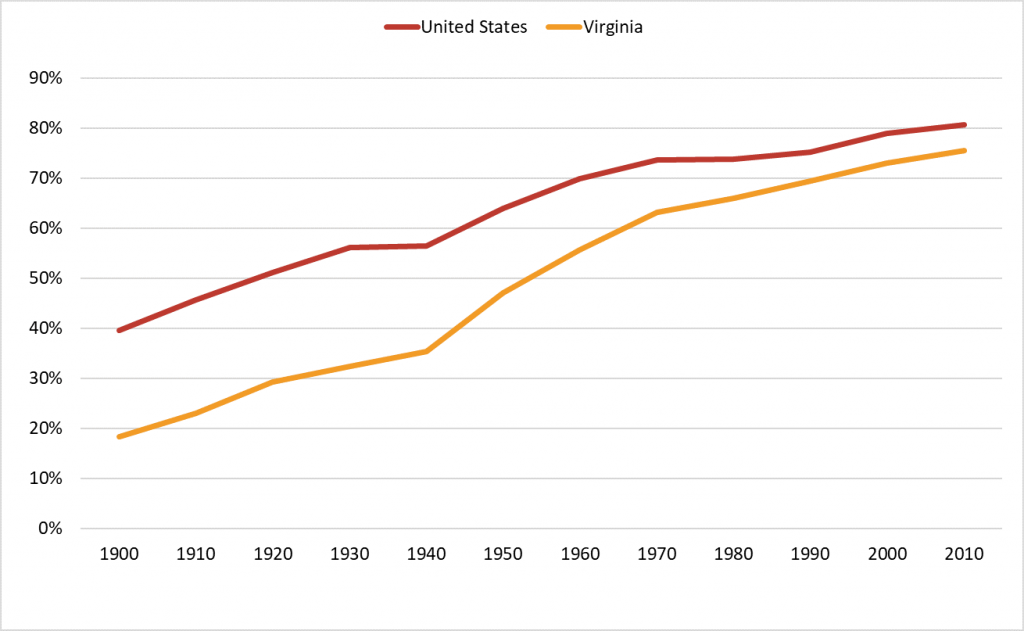Demographic transition theory in a nutshell

Readers of our web series will be familiar with past posts describing population change in Virginia and the factors that drive this change (mortality, fertility, and migration). Although we frequently examine and write about each these components of population change individually, they are intricately intertwined, often in predictable ways. Demographers have observed, for example, that many countries followed a similar pattern of population change following the Industrial Revolution, and they have developed a theory of demographic transition to describe the nature of this pattern. While initially focused on explaining what happens to a population when it switches from having high birth and death rates to low birth and death rates, the theory has expanded to encompass a broader range of interrelated transitions.
Mortality Transition
For most of human history, both mortality and fertility rates were quite high. Food resources were limited, and death from infectious disease was common. About half of all children died before the age of five. Women had to bear about seven children, on average, to ensure that even just two could survive into adulthood (Weeks, 2008, p. 39). As populations develop economically, improve public health, and gain access to advancements in medical science, mortality rates typically decline. This sets into motion what is usually the first in a series of population transformations—the mortality transition. With this transition, death is increasingly postponed to older ages and is more likely to be associated with degenerative rather than infectious disease.
Fertility Transition
In the period of time following the mortality transition but prior to a decline in fertility, the youngest age groups usually surge in size. This is because just as many children are born as before, but greater numbers survive infancy and childhood. As more children begin to survive to older ages, as parents (especially women) begin to perceive that there is benefit to having fewer children, and as family planning becomes a more acceptable and widespread practice within a society, fertility rates, after a delay, also typically decline. (See Figure 1 below.)

Age Transition
As a population’s mortality and fertility rates decline, its age distribution typically shifts from younger to older. The degree to which this age transition occurs depends largely on the degree to which fertility declines in the long run. Figure 2A below shows, for example, the typical younger age structure of a high-mortality/high-fertility population that has not moved through the demographic transition yet. Figure 2B shows the typical older age structure of a population that has low mortality and very low fertility, which is common among many developed countries today. The changing nature of a population’s age structure has enormous potential to impact a society’s economic growth, social stability, and future fertility in both positive and negative ways.
Figure 2A. High Mortality / High Fertility Image

| Figure 2B. Low Mortality / Very Low Fertility Image

|
Migration Transition
If population growth occurs in relation to a society’s movement through the demographic transition without corresponding growth in life opportunity, migration is likely to result. Historically, this migration has been from rural areas (where birth rates are typically higher) to urban areas (where economic opportunity is typically greater), but it also involves migration between countries as well. Whether migrants are “pushed” away from their original location because of undesirable economic, political, or social conditions or “pulled” toward more attractive opportunities elsewhere, migration has the potential to add to or subtract from the size of a population far more quickly than shifts in mortality or fertility. Because young people are the most likely age group to migrate and are of prime reproductive age, the age structures and fertility rates of both the origin and destination locations are affected.
Urban Transition
The urban transition refers to the shift that populations make over time from lifestyles that revolve largely around agricultural activities in rural areas to those that revolve around industrial and commercial activities in urban areas. In addition to accounting for the historical migration of populations from rural to urban areas, the urban transition includes the expansion of urban centers into areas that were previously categorized as rural. It also describes the lifestyle changes that are associated with life in more diverse and densely populated areas. Figure 3 below shows that less than one in five Virginians lived in urban areas in 1900, but by 2010, more than three quarters of the state’s population could be classified as urban.

Note: The definition of urban has changed over the years.
Family and Household Transition
All of the aforementioned transitions contribute to significant changes in family and household structures over time. As both mortality and fertility decline, people (especially women) are able to spend a greater amount of time in pursuit of activities other than bearing and raising children, such as advancing an education and career. Additionally, urbanization facilitates more convenient access to goods and services that in past eras were provided exclusively by family. As a result, marriage and childbearing are often postponed or even forgone, contributing to further declines in fertility. Longer life expectancy also contributes to a greater likelihood of being widowed or divorced, which contributes even further to the diversity of modern-day family and household structures.
Arguably, significant conflicts and movements of our time are rooted in the fact that different populations are at different points in the demographic transition and have varying political, social, and economic resources to deal with this change. The Arab Spring, Brexit, France’s “yellow vest” movement, the U.S. immigration debate and red state/blue state polarization, and Virginia’s NOVA/ROVA dichotomy all involve elements of each of the separate demographic transitions described above. The interesting question is, “What’s next?”…
Reference
Weeks, J. R. (2008). Population: An introduction to concepts and issues (10th ed.). Boston, MA: Cengage Learning.


